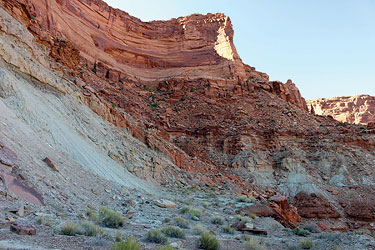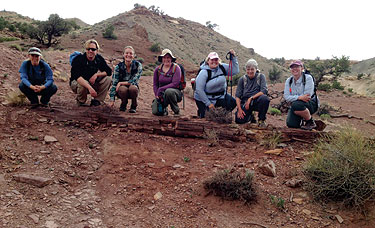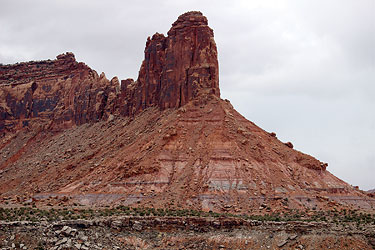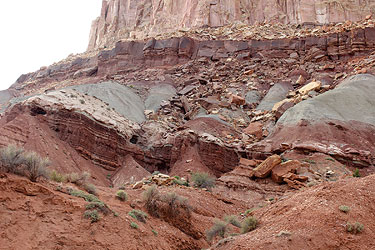 |
| The upper part of the Chinle Formation below the Dead Horse Point area. |
In most areas near Moab, the Chinle Formation doesn't look like much. It makes up the upper portion of the slopes beneath the sheer cliffs formed by the Wingate Sandstone and Kayenta Formation. But the Chinle is usually largely covered by boulders and other debris from rockfalls from the cliffs above it, so that the mudstones, siltstones, and thin sandstones that make up the Chinle aren't usually visible.
The big cliff-forming sandstones like the Wingate and Entrada Sandstones, along with the cliffs and slickrock domes of the Navajo Sandstone, dominate southeastern Utah's scenery. A slope-former like the Chinle Formation doesn't command the same level of attention as towering cliffs do. While the Chinle is a more subtle component of the canyon country landscape than some other rock layers (formations to geologists), it preserves an important chapter in the geologic history of western North America and is treasured by geologists for its fossil record.
The Chinle Formation consists mostly of pastel-colored mudstones and siltstones punctuated by a few thin sandstone beds. It is known for stunning scenery in the candy-striped hills that make up the Painted Desert and in Petrified Forest National Park in northern Arizona, where large fossil logs are also found in great abundance.
 |
| A petrified log in the Chinle in Capitol Reef National Park. |
The Chinle Formation was deposited in and along a large river system that flowed from its headwaters that were to the southeast in what is now New Mexico. These rivers flow across northern Arizona, southwest Colorado, and southern Utah towards the northwest where they flowed into the sea in the Nevada area. This river system was active during the Late Triassic Period from approximately 230 to 201.3 million years ago in the early part of Mesozoic Era (the Age of the Dinosaurs). The age of the Chinle Formation is very well known because it contains deposits of volcanic ash derived from eruptions that occurred west of the Chinle basin. Geologists use ash beds in sedimentary layers to obtain precise ages using radiometric dating techniques that use the decay of radioactive elements in certain minerals. The eruptions must have occurred at the same time as when the ash beds were deposited in the Chinle Formation.
 |
| Candy-striped slopes made of the Chinle Formation beneath the Wingate Sandstone in the Indian Creek area. |
This large river basin contained braided channels and meandering rivers, with areas of lakes, marshes, and large floodplains. Much of the candy striping in the mudstone and siltstone layers reflect ancient soil horizons (paleosols) that formed on floodplains where the water table fluctuated with wet and dry seasons. The climate was tropical and dominated by a monsoonal weather pattern. Some wind-deposited sandstone beds present in the upper part of the Chinle and deposited as the climate became more arid.
Geologists have delineated subdivisions (members) in the Chinle Formation on the basis of different rock types within the unit. The Shinarump Member is the most evident member. The Shinarump is a prominent white sandstone found in some areas at the base of the Chinle. It was deposited only in river channels so it is not present everywhere in the Chinle. The Shinarump even has varying thickness over short intervals where it can be a hundred feet thick or more in the center of an ancient channels and then pinch out completely past where the bank would have been. The Shinarump is not found near Moab, but is found in the larger region of southeastern Utah, and is prominent in Capitol Reef National Park.
 |
| An old uranium mine in the Shinarump Member of the Chinle in Capitol Reef National Park. |
The Shinarump and other channel sandstones in the Chinle (such as the Moss Back Member) were important during the uranium mining era as they were significant sources for ore. Charlie Steen's Mi Vida Mine and other mines in the Lisbon Valley area (the richest mining district in Utah) were located in the Shinarump. The uranium mineralization took place at some point after sedimentary deposition and when uranium was precipitated from circulating groundwaters. Many of the ore deposits found during the early part of the uranium boom were ancient logs that had been replaced with uranium minerals since the organic material provided the right chemical conditions for uranium to be deposited.
The significance of the Chinle's fossil record extends well beyond the fossil logs found in Petrified Forest NP, Escalante Petrified Forest State Park, and elsewhere. The Chinle spans a critical interval in tetrapod (four-limbed vertebrate animals) evolution, and fossils of phytosaurs, other reptiles, early dinosaurs, and mammals have all been found in the rock layer. Phytosaurs are one of the most common types of vertebrate fossils in the Chinle, although frequently as only teeth or skull fragments instead of complete skeletons. Phytosaurs superficially resembled crocodiles, and these predators dominated Chinle channels and swamps.
There are better places other than southeastern Utah to fully explore the Chinle Formation (such as Petrified Forest NP), but the Chinle is still an important part of the geology of the Moab area. It has an important role in the region's human history due to its uranium deposits, contains important fossils, and its subtly striped slopes are attractive in their own right underneath the Wingate Sandstone boulders that largely covering the Chinle. The Chinle shows that sometimes it is worthwhile to look beneath outer surfaces.
|